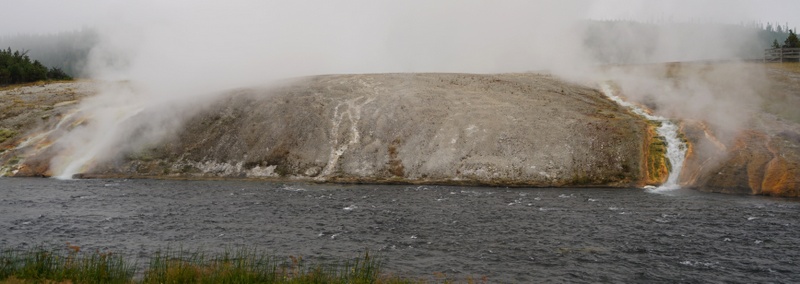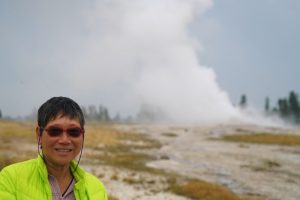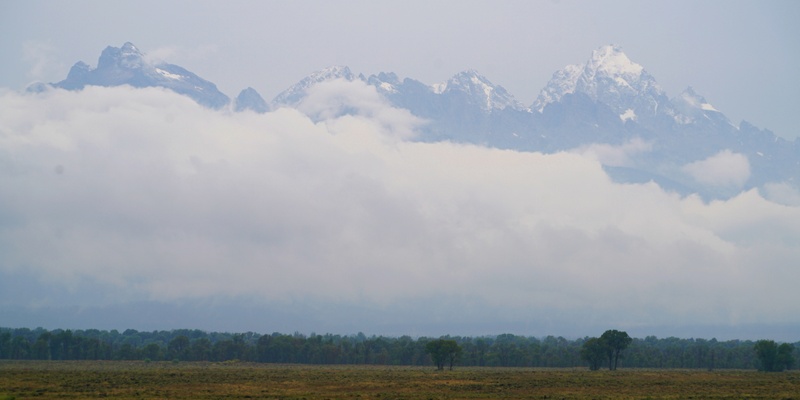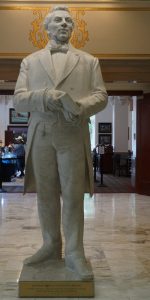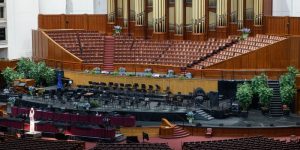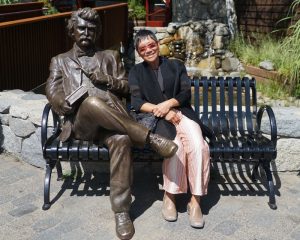Wyoming, South Dakota, Utah and Nevada August 20-24
Day 3 August 20 Monday: Casper WY – Crazy Horse SD – Mount Rushmore SD- Devils Tower WY – Gillette WY (590km)
Today, we were gearing up for three highlights in Native American land and to learn about the injustice, struggles and pains the Native Americans who have suffered with the arrival of colonists, settlers and US government from the 17th to early 20th centuries.
South Dakota (SD) is named after the Lakota and Dakota Sioux Native American tribes that historically dominated the territory. The Black Hills, a group of low pine-covered mountains, are sacred to the Sioux that became dominant by the early 19th century. The natives had been in conflict since the 17th century with the colonists and later the US government and settlers. By the late 19th century, the conflict intensified after a gold rush in the Black Hills and the construction of railroads from the east resulting in the Wounded Knee Massacre in 1890. Native Indian have been subject to unjust treatment and removal policy.
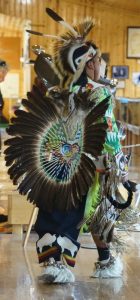 On November 2, 1899, SD became a state with an area of 199,729 km2. Today, it is the fifth smallest by population (about 900,000). According to the 2010 census, about 8.8% of the population are American Indian and Alaska Native. Most of the Native American live in reservations located in West River.
On November 2, 1899, SD became a state with an area of 199,729 km2. Today, it is the fifth smallest by population (about 900,000). According to the 2010 census, about 8.8% of the population are American Indian and Alaska Native. Most of the Native American live in reservations located in West River.
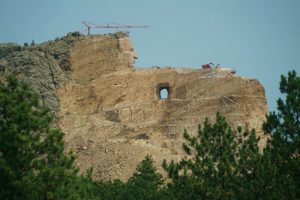 We set off at 6:45 am and arrived at the Crazy Horse Memorial just before 10 am. Constructed on privately held land in the Black Hills, the memorial shows Crazy Horse (c. 1840-1877), an Oglala Lakota war hero, riding a horse and pointing into the distance. He was remembered for his bravery and famous actions against the US military that includes the Fetterman fight (December 21, 1866) and the Battle of the Little Bighorn (June 25-26, 1876). He surrounded to US troops under General Crook in June 1877 and was fatally wounded and died four months later.
We set off at 6:45 am and arrived at the Crazy Horse Memorial just before 10 am. Constructed on privately held land in the Black Hills, the memorial shows Crazy Horse (c. 1840-1877), an Oglala Lakota war hero, riding a horse and pointing into the distance. He was remembered for his bravery and famous actions against the US military that includes the Fetterman fight (December 21, 1866) and the Battle of the Little Bighorn (June 25-26, 1876). He surrounded to US troops under General Crook in June 1877 and was fatally wounded and died four months later.
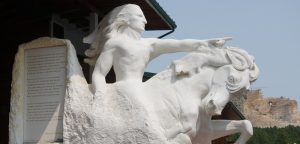 The memorial was commissioned by Henry Standing Bear, a Lakota elder and works began by sculptor by Korczak Ziolkowski in 1948. Today we can see the head of Crazy Horse (27m high) while work on the horse sculpture is in progress. The sculpture’s final dimensions are planned to be 195m high and 172m wide. It might take another 70 years or more to complete the memorial. Definitely, I won’t see the majestic sculpture in my life time.
The memorial was commissioned by Henry Standing Bear, a Lakota elder and works began by sculptor by Korczak Ziolkowski in 1948. Today we can see the head of Crazy Horse (27m high) while work on the horse sculpture is in progress. The sculpture’s final dimensions are planned to be 195m high and 172m wide. It might take another 70 years or more to complete the memorial. Definitely, I won’t see the majestic sculpture in my life time.
We spent about an hour in the Indian Museum of North America which has lots of photos and artefacts from various American Indian tribes. There was a dance performance by a native Indian. But I watched for a few minutes so that I could spend time in the museum.
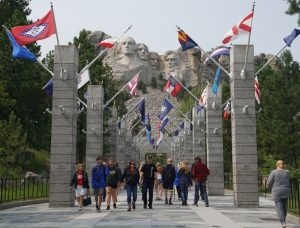 Then we drove to Mount Rushmore National Memorial, an iconic symbol of the US. The idea of carving famous people into the sacred Black Hills region as a prime tourist attraction is credited to SD historian Doane Robinson. But the choice of the sculpture subject was left solely to Sculptor Gutzon Borglum (1867-1941) who designed and oversaw the project from 1927 to 1941 with the help of his son Lincoln Borglum.
Then we drove to Mount Rushmore National Memorial, an iconic symbol of the US. The idea of carving famous people into the sacred Black Hills region as a prime tourist attraction is credited to SD historian Doane Robinson. But the choice of the sculpture subject was left solely to Sculptor Gutzon Borglum (1867-1941) who designed and oversaw the project from 1927 to 1941 with the help of his son Lincoln Borglum.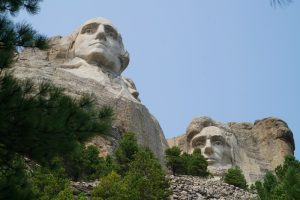
Borglum finally decided to carve into the granite face of Mount Rushmore the busts of four presidents who in his view had played pivotal roles in American history. They are President George Washington (1732-1799), Thomas Jefferson 1743-1826), Theodore Roosevelt (1858-1919) and Abraham Lincoln (1809-1865).
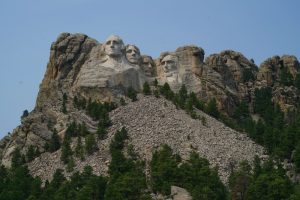 Washington (1st President April 1789 – March 1797) was the father of the nation. Jefferson (3rd President March 1801 – March 1809) was the principal author of the Declaration of Independence. Lincoln (16th President March 1861 – April 1865) led the nation through the Civil War, preserved the union, abolish slavery, strengthened the federal government and modernised the economy. Roosevelt (25th President September 1901 – March 1909) was the driving force for the progressive era in the US in the early 20th century.
Washington (1st President April 1789 – March 1797) was the father of the nation. Jefferson (3rd President March 1801 – March 1809) was the principal author of the Declaration of Independence. Lincoln (16th President March 1861 – April 1865) led the nation through the Civil War, preserved the union, abolish slavery, strengthened the federal government and modernised the economy. Roosevelt (25th President September 1901 – March 1909) was the driving force for the progressive era in the US in the early 20th century.
We had free time from 1 to 2:45pm. I skipped lunch so that I could wander around the memorial park which covers 5.17 km2. At 1:30 pm, I joined a guide tour where the guide talked about the history, geology and how carving had been done.
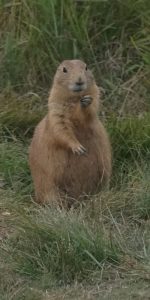 After the tour, I visited the museum which details the construction of the memorial. I had an ice cream which only came in one size with two big scoops ($6). Ice cream is already an unhealthy substitute for lunch. Excessive portion in my view greatly attributes to the problem of obesity and health in the US. I watched with dismay how I put on weight as I travelled through America.
After the tour, I visited the museum which details the construction of the memorial. I had an ice cream which only came in one size with two big scoops ($6). Ice cream is already an unhealthy substitute for lunch. Excessive portion in my view greatly attributes to the problem of obesity and health in the US. I watched with dismay how I put on weight as I travelled through America.
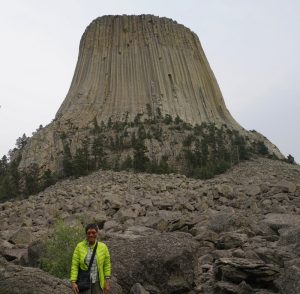 We departed at 2:45pm for the Devils Tower, the nation’s first national monument, anointed by President Roosevelt in 1906. We crossed the state boundary around 4:15 pm and were back in WY.
We departed at 2:45pm for the Devils Tower, the nation’s first national monument, anointed by President Roosevelt in 1906. We crossed the state boundary around 4:15 pm and were back in WY.
This massive monolith in the Black Hills rising 386m above the Belle Fourche River, is considered sacred by many Native Americans. The column measures 265m from summit to base and the summit is 1,559m above sea level. We had an hour and I was able to take on the 2-km trek around the magnificent and unique rock column. It is a spiritual and atmospheric walk.
We departed at 6:15 pm and arrived at Ramada Hotel in Gillette at 7:30 pm. I had a beer, grilled salmon and rice in a Japanese restaurant in the hotel. But the waiters and chefs are Chinese.
Remark: A wonderful day
Day 4 August 21 Tuesday: Gillette WY – Yellowstone WY– Madison, Montana (about 400km)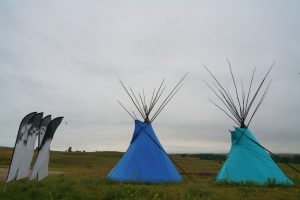
We started early at 6:45am and were soon back in MT soil. It was an overcast day with occasional shower. We had a toilet stop at 9:15 am at the battle field of Little Bighorn where Crazy Horse had fought the US troops.
The weather improved. We were taking Interstate 90, the longest east-west transcontinental freeway in the US at 4,861km from Boston to Seattle. We had lunch at Arby, another fast food chain. It’s the first time I tried its roast beef sandwich ($ 3.3). I like it: the meat is tender and not salty.
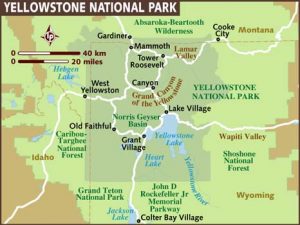
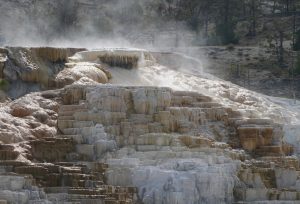 I was excited when we were approaching the Yellowstone National Park, the largest, oldest, and most famous national park in the US displaying a fascinating scenery of hot springs, geysers, canyons, waterfalls, and nature. The park sitting on the Yellowstone Plateau at an average elevation of 2,400m above sea level, is 101 km north to south and 87 km west to east by air. The majority of the land area of the park lies in WY
I was excited when we were approaching the Yellowstone National Park, the largest, oldest, and most famous national park in the US displaying a fascinating scenery of hot springs, geysers, canyons, waterfalls, and nature. The park sitting on the Yellowstone Plateau at an average elevation of 2,400m above sea level, is 101 km north to south and 87 km west to east by air. The majority of the land area of the park lies in WY 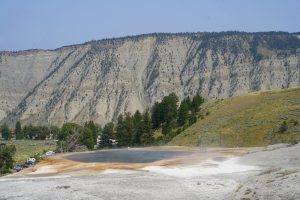 (96%); 3% in Montana (MT) and 1% in Idaho (ID). The fires in 1988 destroyed about a third of the forest.
(96%); 3% in Montana (MT) and 1% in Idaho (ID). The fires in 1988 destroyed about a third of the forest.
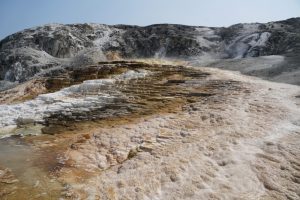 I enjoyed watching the ever-changing landscape and vegetation on our way to the park. We also saw marmot, deer, elk and bison. We entered from the north entrance and had three stops in the afternoon.
I enjoyed watching the ever-changing landscape and vegetation on our way to the park. We also saw marmot, deer, elk and bison. We entered from the north entrance and had three stops in the afternoon.
Mammoth Hot Springs This large complex of hot springs is spectacular both for its unique beauty and scale. Formed hundreds of thousands of years ago by volcanic and seismic activity, these springs are one of Yellowstone’s most popular spots.
I have seen this type of geological formation. But this cluster is the largest and most impressive one I have ever seen. There are half a dozen walks over an expansive field of colourful springs and I had problem in deciding where to go within 40 minutes.
I decided to walk to the main terrace at the top which would afford panoramic views. At the end, I managed to see a few spots. The scenery should be more impressive if there would be more water. I wished I had more time to stroll in leisure.
Grand Canyon of the Yellowstone The gorgeously coloured canyon is approximately 39km long and between 240 and 370m deep and from .40 to 1.21km wide. We had 45 minute at the Artist Point that affords the best view of the Yellowstone Falls and the impressive gap in the first large canyon on the Yellowstone River downstream from Falls.
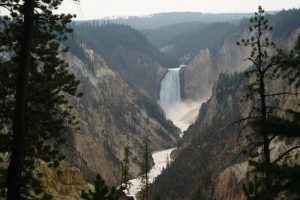
 While most people were busy posing for photos at the lookout point, I took a path with few visitors. The view of the canyon with more colourful cliff faces is equally beautiful and remarkable.
While most people were busy posing for photos at the lookout point, I took a path with few visitors. The view of the canyon with more colourful cliff faces is equally beautiful and remarkable.
Yellowstone Falls The last stop of the day was the Brink of Upper Falls. We had 40 minutes to walk to the platform just above the Yellowstone River and the upper waterfall. But it is the Lower Falls that is more impressive: they stand more than 91m tall– almost twice as high as Niagara Falls and are the largest by volume in the Rocky Mountains of the western US.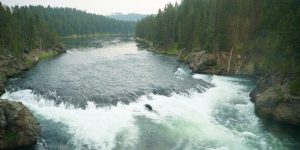
On the way out, we saw a bison crossing the road. We exited from the West Entrance and were back in MT after 6 pm. Peter took us to a Sichuan restaurant in Madison and I had chili fish and rice for $28. Not cheap but delicious! We spent a night in the Dude Motel in Madison.
Remark: A good but rush time in Yellowstone
Day 5 August 22 Wednesday: Madison MT- Yellowstone WY– Grand Teton – Jackson Hole WY – Salt Lake UT (530km)
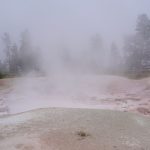 We had to get up before 6 am for departure at 6:45 am. But something was wrong with the coach and all the men tried to help the driver to fix it. Finally, we set off around 7 am. We were back in the park with five minutes and drove to the geyser basins.
We had to get up before 6 am for departure at 6:45 am. But something was wrong with the coach and all the men tried to help the driver to fix it. Finally, we set off around 7 am. We were back in the park with five minutes and drove to the geyser basins.
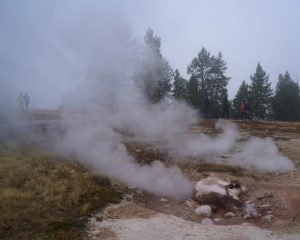 It was cold around 2-5°C. There was frost on the ground. It was magical to watch the rising sun, the forest and mountain ranges through morning mist. Steam was rising from the river. The scenery was enchanting and atmospheric. We had three stops in the Geyser Basin.
It was cold around 2-5°C. There was frost on the ground. It was magical to watch the rising sun, the forest and mountain ranges through morning mist. Steam was rising from the river. The scenery was enchanting and atmospheric. We had three stops in the Geyser Basin.
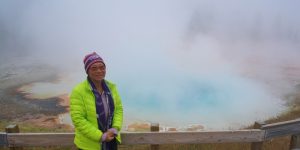 Lower Geyser Basin We were the second coach to arrive and had 30 minutes to take the boardwalk to see two large pools with blue water, small geysers, a few mud pools and fumeroles.
Lower Geyser Basin We were the second coach to arrive and had 30 minutes to take the boardwalk to see two large pools with blue water, small geysers, a few mud pools and fumeroles.
We walked in mist. Though it’s not possible to see the post-card blue colour in the pools, I was lost in time having a surreal experience.
Midway Geyser Basin We crossed a steel bridge and watch boiling water from the Excelsior Geyser dumping into the Firehole River. The colours of the rocks are amazing.
I followed the boardwalk which takes us to the Grand Prismatic Hot Spring, Excelsior Geyser, Grand Spring Opal Pool and the Turquoise Pool.
I first walked past the Excelsior Geyser which is an enormous geyser crater. I watched with awe at the runoff water dumping in the Firehole river. The colours are amazing.
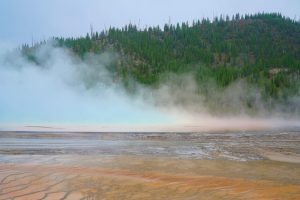
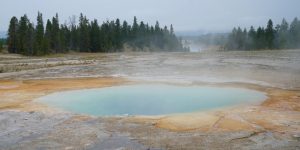 Next I arrived at the Grand Prismatic Hot Spring, the most photographed thermal feature in Yellowstone. Extremely hot water travels 37m from a crack in Earth to reach the surface of the spring, the third largest in the world with a diameter of 113m. It gets its colour from bacteria around its rim that feed off the mineral-rich water. In the summer months, the hot spring is a vivid red-orange shade. I did not see the vivid colours owing to mist.
Next I arrived at the Grand Prismatic Hot Spring, the most photographed thermal feature in Yellowstone. Extremely hot water travels 37m from a crack in Earth to reach the surface of the spring, the third largest in the world with a diameter of 113m. It gets its colour from bacteria around its rim that feed off the mineral-rich water. In the summer months, the hot spring is a vivid red-orange shade. I did not see the vivid colours owing to mist.
Upper Geyser Basin Our final stop was at Old Faithful, a geyser that erupts every 91 minutes. We arrived before 9am and the eruptions came about five minutes later. I took the boardwalk around the Old Faithful. and had a glimpse of numerous geysers on the other side of the stream.
This area has at least 150 geysers in this basin. I saw smokes coming up (I presume from geysers and springs) on the other side of the river. I could have spent an hour or two to explore this cluster of geysers.
We set off after 9:30am. The weather changed fast and while we were still driving through the park, it started to rain heavily. Everything looked grey and lifeless. We exited through the East Entrance and soon arrived at the Grand Teton National Park located in the Rocky Mountains, Northwest WY. It is noted for its stunning mountain vistas, shimmering alpine lakes and abundant wildlife. But we did not have a chance to get out of the coach owing to the rain. When it stopped briefly, we got out to take a photo of peak of Grand Teton half covered in clouds.
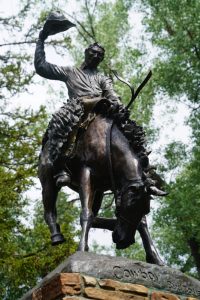 The valley provides good habitat for beaver and other fur-bearing animals. We passed by the National Elk Refuge before arriving at Jackson Hole the gateway to the Grand Teton and Yellowstone National Parks. Located in a valley an elevation of 1,900m between the Teton Mountain Range and the Gros Ventre Range, it is a picturesque upmarket resort town with a population of 10,000.
The valley provides good habitat for beaver and other fur-bearing animals. We passed by the National Elk Refuge before arriving at Jackson Hole the gateway to the Grand Teton and Yellowstone National Parks. Located in a valley an elevation of 1,900m between the Teton Mountain Range and the Gros Ventre Range, it is a picturesque upmarket resort town with a population of 10,000.
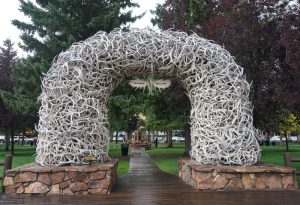 It was still drizzling. We had about two hours for lunch and exploration. The town has a few main streets that are wooden buildings and lined with eateries, galleries and shops. I visited a dozen of galleries and noted many paintings and sculptures are selling at over $1,000!
It was still drizzling. We had about two hours for lunch and exploration. The town has a few main streets that are wooden buildings and lined with eateries, galleries and shops. I visited a dozen of galleries and noted many paintings and sculptures are selling at over $1,000!
The rain had stopped. The fresh air was refreshing and cool after the rain. I went to the famous park with elk-horn arcs at each corner. Elks arrive at the refuge every year in winter and shed their horns. Boy scouts are sent to pick up the horns.
I had a beef noodle soup in a Thai restaurant for $12. Delicious and very reasonable!
After lunch, we were back on the road heading south to Salt Lake City for the night. We followed the highway which forms the state boundary between WY and ID. Peter showed a video but I was too tired to watch. By the time the next film “The Other Woman” was shown, I was fully awake and enjoyed it.
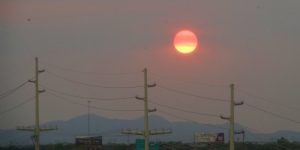 We arrived at RL Hotel in Salt Lake City before 7 pm. I watched sunset from my room and did not go out to explore the city after 8 pm. The receptionist gave me a map and told me to take a free tram from the main road to the centre city. I walked for several blocks and found the place dark and dead quiet. Apart from hotels, I hardly found shops, bars and eateries. I was excited when I saw a Japanese restaurant “Simply Sushi” and was disappointed when I found it close since 8pm.
We arrived at RL Hotel in Salt Lake City before 7 pm. I watched sunset from my room and did not go out to explore the city after 8 pm. The receptionist gave me a map and told me to take a free tram from the main road to the centre city. I walked for several blocks and found the place dark and dead quiet. Apart from hotels, I hardly found shops, bars and eateries. I was excited when I saw a Japanese restaurant “Simply Sushi” and was disappointed when I found it close since 8pm.
I discovered the only places that was still in operation in the neighbourhood were McDonald, the gas station and the liquor shop. I bought a bottle of white wine and ribs from McDonald and returned to the hotel. I spent the evening watching CNN which reported Michel Cohen, Trump’s former lawyer and fixer pleading guilty implicating Trump was behind the hush money payment to Stormy Daniels. I find Trump narcissistic, unscrupulous and unbearable. Today American politics is a reality show. When and how will the show end? I wonder. I pray he will not bring disaster and pain to the rest of the world.
Day 6 August 23 Thursday: Salt Lake UT-Bonneville Salt Flats – Reno (703km)
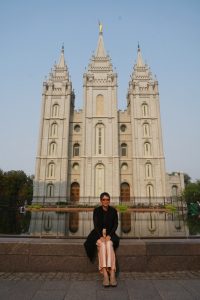 UT has an area of about 220,00 km2 and a population of 3 million. About 62% of population are reported to be members of The Church of Jesus Christ of Latter-day Saints (LDS), often known as Mormons. It was not admitted to the US till January 1896 after polygamy was outlawed in 1890. Salt Lake City (commonly known as Salt Lake) with an estimated population of 200,000 is the capital of the state.
UT has an area of about 220,00 km2 and a population of 3 million. About 62% of population are reported to be members of The Church of Jesus Christ of Latter-day Saints (LDS), often known as Mormons. It was not admitted to the US till January 1896 after polygamy was outlawed in 1890. Salt Lake City (commonly known as Salt Lake) with an estimated population of 200,000 is the capital of the state.
Mormons trace their origin to the visions that Joseph Smith reported he had in the early 1820s. He published in 1830 the Book of Mormon, named after Mormon, the ancient prophet-historian who compiled the book. Smith founded the Church of Christ in upstate New York in April 1830 and started to move westward when expelled in Ohio, Missouri and Illinois. In June 1844, he and his brother and successor Hyrum, were killed by a mob in Carthage, Illinois. Brigham Young, a senior apostle of the Quorum of the Twelve succeeded and finally settled down in the present-day Utah in 1847.
Mormons have since greatly expanded their missionary efforts. Today, there are over 16 million Mormons worldwide.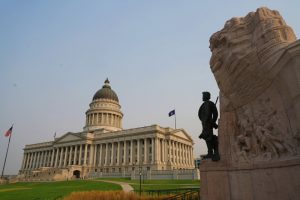
We set off at 8am to visit the Utah State Capitol Building located on a hillside overlooking the city. There were few visitors and I had a pleasant stroll!
Then we spent over an hour in the Temple Square, approximately ten acres in size. The Square is the center of religious activity for the LDS, housing the Temple and Tabernacle that are central to the religion.
We went to the LDS Convention Centre completed in 2000 with 21,000-seating capacity, the venue for its conference in April and October.
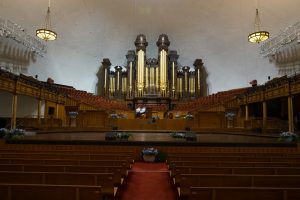 Next, we walked to the Salt Lake Temple, an icon of the city which street grid system is based on the temple at its centre. Only Mormons can enter the Temple which construction started in 1853 and completed in 1893. Peter took us to see the marble statue of Joseph Smith before we went to the top floor for a panoramic view of the square. I think it offers the best sunset view of the city. On the way out, I slipped into the Tabernacle which houses an organ consisting of 11,623 pipes.
Next, we walked to the Salt Lake Temple, an icon of the city which street grid system is based on the temple at its centre. Only Mormons can enter the Temple which construction started in 1853 and completed in 1893. Peter took us to see the marble statue of Joseph Smith before we went to the top floor for a panoramic view of the square. I think it offers the best sunset view of the city. On the way out, I slipped into the Tabernacle which houses an organ consisting of 11,623 pipes.
The sun was out. I could see the expansive salt flats on the return journey. Once we left the city, we drove on the salt flats for an hour before reaching the Bonneville Salt Flats. As I have visited the spectacular Salar de Uyuni in Bolivia and the Chaka Salt Lake in China, I do not find the Great Salt Lake in the US striking.
 We were driving on Route 80 all the way to Reno, ND. around 6 pm. We stayed at Harrahs with a big casino on the ground floor. To encourage guests to spend time in the casino, the hotel does not provide Wi-Fi in the rooms. There is also no writing desk.
We were driving on Route 80 all the way to Reno, ND. around 6 pm. We stayed at Harrahs with a big casino on the ground floor. To encourage guests to spend time in the casino, the hotel does not provide Wi-Fi in the rooms. There is also no writing desk.
I walked along the main street and went inside a couple of casinos. I bought a take-away and had it in my room. As I had no desk to write, I went to the casino around 9pm. There were not many customers. I sat in front of an one-armed bandit slot machine and lost $9 in 20 minutes. Not bad!
Remark: Geysers and hot springs in Yellowstone are most spectacular
Day 7 August 24 Friday: Reno ND – Sacramento CA (300km)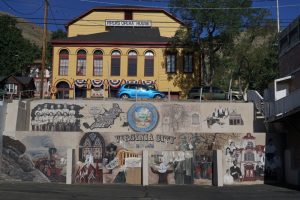
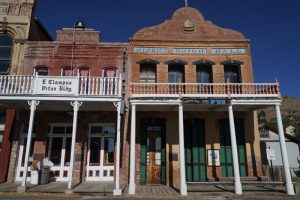 Silver and gold made the old mining town Virginia City, one that is recognized as the character of Nevada. At 8 am, we departed for Virginia City which is about 40km from Reno.
Silver and gold made the old mining town Virginia City, one that is recognized as the character of Nevada. At 8 am, we departed for Virginia City which is about 40km from Reno.
The city has a main street filled with historic buildings built with wood. We only had half an hour. The town has a cinematic feel. I walked to two churches below the main street and the opera house above it. There is a Mark Twain Museum as he had lived here.
We departed when two coaches full of Mainland visitors arrived. We had a pleasant ride to Lake Tahoe, the largest alpine lake in North America. It is a tourist destination year-round.
Again, we spent half an hour here. I was surprised to find a statue of Mark Twain with “Adventure of Huckleberry Finn” in his hand. Coincidentally, I had been reading this book and “The Adventure of Tom Sawyer” on the coach. I therefore asked a tourist to take a photo for me with Twain.
After a McDonald lunch, we were back on the road around 2:30 pm heading to Sacramento. I asked Peter to drop me off in Sacramento where I would visit Isabel and George, my primary school friends since 1963. Around 3:45 pm, I saw them waiting for me at a road junction off the highway. I got off the coach and said good-bye to Peter, the driver and my new friends.
Happy Ending of a whirlwind tour of Yellowstone






